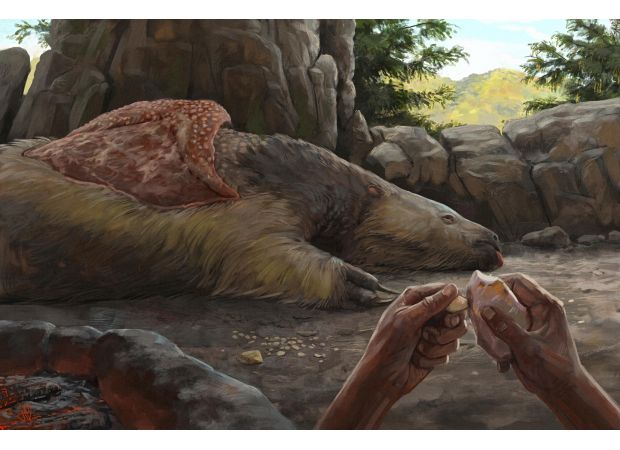New evidence shows that giant sloths and mastodons coexisted with humans in the Americas for thousands of years.
Sloths used to be large and fast animals, but now they are slow and live in trees. Their ancient relatives were even bigger and had huge claws.

Long ago, sloths were not the slow, gentle creatures we know today. Their ancestors were massive, weighing up to 4 tons. When startled, they would reveal their immense claws, a defense mechanism passed down through generations.
For many years, scientists believed that the first humans to arrive in the Americas quickly wiped out these giant ground sloths, along with other massive animals like mastodons, saber-toothed cats, and dire wolves that once roamed North and South America. However, new research from various sites is challenging this idea and suggesting that humans may have arrived on the continent much earlier than previously thought. These findings paint a different picture of the early Americans, one in which they coexisted with enormous beasts for thousands of years.
According to Daniel Odess, an archaeologist at White Sands National Park in New Mexico, there was a concept known as "Pleistocene overkill" that suggested humans arrived and rapidly caused the extinction of these animals. But the recent discoveries indicate that humans and these creatures lived alongside each other for at least 10,000 years without causing their extinction.
One of the most intriguing pieces of evidence comes from the Santa Elina archaeological site in central Brazil, where bones of giant ground sloths show signs of human manipulation. These sloths once roamed from Alaska to Argentina and some species had bony structures on their backs, similar to modern armadillos, which may have been used for decoration.
In a lab at the University of Sao Paulo, Mírian Pacheco, a researcher, holds a round, penny-sized sloth fossil in her palm. She points out that its surface is remarkably smooth, with deliberate polishing around the edges and a small hole near one edge. Pacheco believes this fossil was intentionally altered and used as jewelry or adornment by ancient people. Three other similar fossils, known as "pendants," are visibly different from unworked osteoderms (the bony structures) found on the table, which are rough and without any holes.
These artifacts from Santa Elina are approximately 27,000 years old, more than 10,000 years earlier than scientists initially thought humans arrived in the Americas. Initially, researchers questioned whether the craftsmen were working on already old fossils. However, Pacheco's research strongly suggests that ancient people were carving fresh bones shortly after the animals died.
Her findings, along with other recent discoveries, could change our understanding of when humans first arrived in the Americas and their impact on the environment. Pacheco acknowledges that there is still a significant debate among scientists about this topic.
It is widely known that the first humans emerged in Africa and then migrated to Europe, Asia-Pacific, and finally, the Americas. However, the exact timeline of this journey remains a mystery. In high school, Pacheco was taught the theory that most archaeologists held throughout the 20th century, which stated that Clovis (a site in New Mexico) was the first evidence of human presence in the Americas.
Clovis is a site where archaeologists discovered distinctive projectile points and other artifacts dating back to between 11,000 and 13,000 years ago. This date coincides with the end of the last Ice Age, when an ice-free corridor may have opened up in North America, allowing humans to enter the continent after crossing the Bering land bridge from Asia. This theory also suggests that humans caused the mass extinction of American megafauna around this time, with North America losing 70% of its large mammals and South America losing more than 80%.
Paleoanthropologist Briana Pobiner from the Smithsonian Institution's Human Origins Program explains that this theory was widely accepted for many years because it lined up with the timeline of events. However, new research methods, such as ancient DNA analysis and new laboratory techniques, combined with the examination of additional archaeological sites and the inclusion of more diverse scholars across the Americas, have challenged this narrative and raised new questions, particularly about the timing of human arrival.
According to Richard Fariña, a paleontologist at the University of the Republic in Montevideo, Uruguay, findings from various older sites continue to emerge, which is causing intense scrutiny among scientists. However, they are also compelling and provide evidence that humans may have arrived in the Americas even earlier than previously thought.
Pacheco and her team study the chemical changes that occur when a bone becomes a fossil at the Federal University of Sao Carlos. This allows them to analyze when the sloth osteoderms were likely modified. They discovered that the osteoderms were carved before the fossilization process in fresh bones, which means they were modified anywhere from a few days to a few years after the sloths died, not thousands of years later. They also ruled out natural processes, such as erosion and animal gnawing, as possible causes of the modifications. This research was published in the journal Proceedings of the Royal Society B.
Another collaborator, paleontologist Thaís Pansani, is studying whether similar-aged sloth bones found at Santa Elina were charred by human-made fires, which burn at different temperatures than natural wildfires. Her preliminary results suggest that the fresh sloth bones were present at human campsites, but it is uncertain whether they were intentionally burned for cooking or were simply nearby. She is also ruling out other possible causes for the black markings, such as natural chemical discoloration.
The oldest site widely accepted as older than Clovis is in Monte Verde, Chile. Researchers discovered stone tools, animal hides, and various plants dating back 14,500 years, buried beneath a peat bog.
Tom Dillehay, an archaeologist at Vanderbilt University and a longtime researcher at Monte Verde, describes the site as shocking, with an abundance of organic materials preserved at the end of the world.
Some archaeological sites suggest even earlier dates for human presence in the Americas, such as Arroyo del Vizcaíno in Uruguay, where researchers are studying apparent human-made cut marks on animal bones dating back to about 30,000 years ago. At White Sands National Park, researchers have uncovered human footprints dating back 21,000-23,000 years, alongside tracks of giant mammals. However, some archaeologists question the lack of stone tools at this site, wondering why humans would leave footprints but no artifacts.
Odess, the archaeologist at White Sands National Park, welcomes such challenges and explains that they did not set out to find the oldest anything. Instead, they have followed the evidence and where it leads. Although the exact timing of humans' arrival in the Americas remains contested and may never be known, one thing seems clear: if they arrived earlier than once thought, they did not immediately cause the extinction of the giant beasts they encountered. The footprints at White Sands preserve a few moments of early interactions between humans and these massive creatures. One set of tracks shows a giant ground sloth walking on all fours when it comes across the footprints of a small human who had recently dashed by. The sloth then stands up on its hind legs, looks around, and heads off in a different direction.






